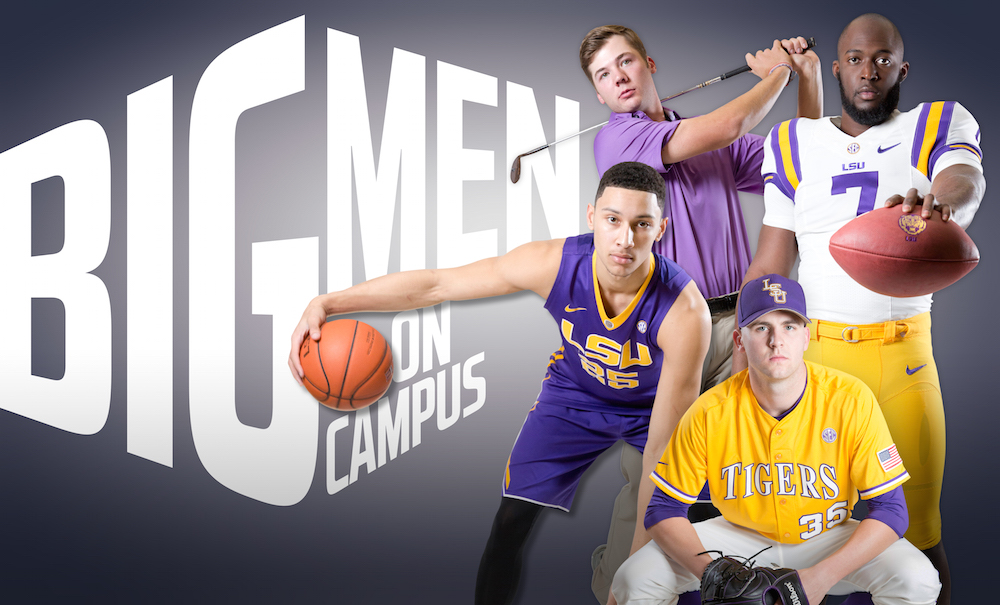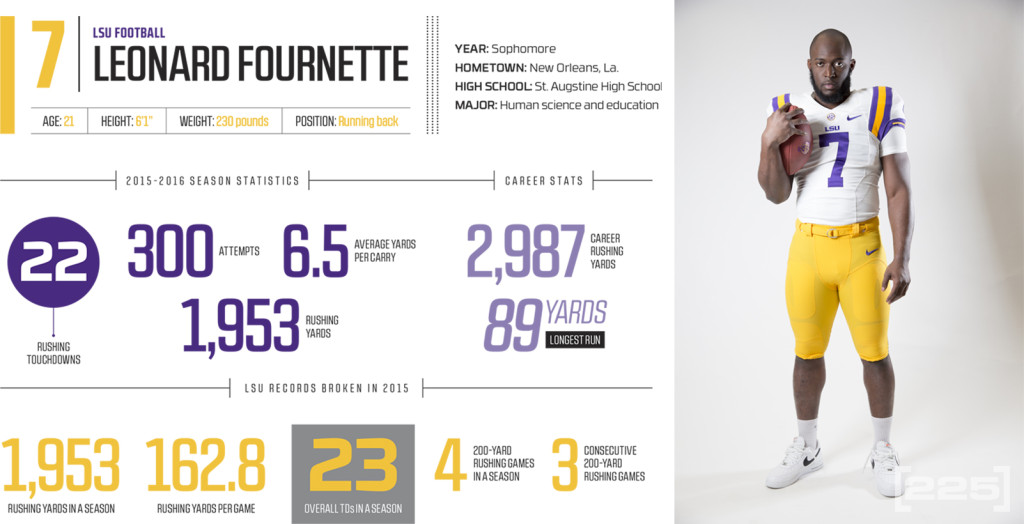
Four of the nation’s top collegiate athletes call Baton Rouge home
Tiger fans know them by heart, the famous names that jump out at you from LSU sports lore. Bob Pettit, Billy Cannon, Tommy Casanova, Pete Maravich, Rudy Macklin, David Toms, Ben McDonald, Seimone Augustus, Shaquille O’Neal … just to name a few.
It would be hard to top the list of great athletes who have come through the Ole War Skule since LSU began fielding sports teams more than 120 years ago.
But all at once?
|
|
Consider what’s happening on campus now, just a semester removed from the exit of one of the greatest baseball players the school has ever known, shortstop Alex Bregman, who was the No. 2 pick of the Major League Baseball draft last June.
LSU currently boasts a group of athletes who are among the best—if not the best—players in four college sports:
Superstar freshman basketball player Ben Simmons, the Australian who is a Baryshnikov on the hardwood and likely will be the No. 1 pick in June’s NBA Draft.
Sophomore Leonard Fournette, a wrecking ball of a running back from New Orleans who is surely among the top few favorites to win the Heisman Trophy in 2016.
The No. 1 golf recruit in the nation in Shreveport’s Sam Burns, whose credentials are a big boost to a team preparing to defend its NCAA men’s championship.
And Alex Lange, a sophomore pitcher from Lee’s Summit, Missouri, who came in highly touted and then stunned the college baseball world by going 12-0 as a freshman.
 What’s more, you would be hard-pressed to find anyone to say anything negative about the foursome as people and students. They’re bright and thoughtful in interviews, and they understand the big picture of which they’re such big parts.
What’s more, you would be hard-pressed to find anyone to say anything negative about the foursome as people and students. They’re bright and thoughtful in interviews, and they understand the big picture of which they’re such big parts.
“Being even considered in with those guys is awesome,” Lange says, perhaps selling himself short.
“Just the way Leonard conducts himself on and off the field, Ben the same way, with class, there’s something to be learned from that. With all the success they’ve had, I can’t even put myself on that pedestal with them. It’s pretty awesome to be here in school while they’re doing their thing and to be around them while they’re here.”
There is a musical called Million Dollar Quartet, featuring a 1956 jam session among Elvis Presley, Jerry Lee Lewis, Carl Perkins and Johnny Cash. Fast forward almost 60 years, and you have LSU’s version. You can rest assured that this quartet will make way, way more than a million once they’re pros.
For example, if he’s the No. 1 draft pick, Simmons would make nearly $5 million next year in the NBA. But money, just like fame, doesn’t seem to faze the 6-foot-10 do-everything player. A morning appearance on ESPN’s SportsCenter, a gaggle of local media surrounding him in the afternoon, with a national writer or two sprinkled into the mix—that was a typical day for Simmons during the season.
He’s become a household hoops name, but he says he doesn’t think of himself as famous. Simmons figures it was about three years ago when he seemed to become a regular on either SportsCenter or ESPN broadcasts of his high-school games.
“It’s been so different for me growing up,” says Simmons, 19. “Now it’s on a different level.”
Different? When President Barack Obama came to Baton Rouge in January, Simmons was not only in the McKinley High School crowd, he got a shout-out from the president. On campus, he doesn’t even try to hide.
“It’s cool,” Simmons says. “Everyone says hi, and everyone’s friendly, and I love that part of it.”
Selfies and autographs are de rigueur, but one student also asked him to sign an expensive pair of shoes.
“He’s handled it amazingly,” says senior teammate Keith Hornsby, son of musician Bruce Hornsby, who knows about the effects of stardom. “He hasn’t let it get to his head.”
 Simmons is not the first student to feel the effects of stardom, and he is honored to be a part of a school with the athletic traditions LSU has. Being on campus with so many other great athletes is important to Simmons.
Simmons is not the first student to feel the effects of stardom, and he is honored to be a part of a school with the athletic traditions LSU has. Being on campus with so many other great athletes is important to Simmons.
“Being with or surrounding yourself with people who are at the same level as you or want to be and who have the same dreams and aspirations as you helps you hold yourself to that level,” Simmons says. “When they step up, it makes you want to step up and compete.”
“I love seeing Leonard do well because it make me work harder.”
Whereas Simmons can turn pro after his freshman year, Fournette, who turned 21 in January, is bound by NFL rules to play one more season.
Fournette is a self-driven athlete like few others. His experiences growing up, not the least of which was surviving the hardships of Hurricane Katrina, combined with his gregarious personality and remarkable football abilities, made him a household name last fall.
He had a really good freshman season, becoming one of the better running backs in the country in the last half of 2014. Then in 2015, Fournette became quite simply remarkable.
He became the first LSU player ever and first Southeastern Conference player to lead the nation in rushing since 1949. His rushing totals of 1,953 yards and 22 touchdowns, both LSU records, included rushing for more than 200 yards four times and 100 yards 10 times. And he accomplished all this even while missing one game. LSU’s season opener against McNeese State was called off because of bad weather.
Fournette enters his junior year fourth on the all-time LSU list, behind Kevin Faulk, Dalton Hilliard and Charles Alexander, all of whom had strong NFL careers.
The 6-foot-1, 230-pounder has speed that belies his size and power that has shaken up more than a few defenders. There were times last fall when the Saturday-night TV recaps were composed of nothing but Fournette highlights.
“It’s like being friends with Michael Jordan,” Lange says. “The way he conducts himself at all times with class is incredible. He doesn’t let the moment let him get away from who he is. If you follow him on Twitter, he’s always posting pictures with his daughter. That’s the kind of guy he is.”
Fournette capped off the season by rushing for 212 yards and scoring five touchdowns in LSU’s bowl victory over Texas Tech. After a season in which many expected him to be one of the three Heisman Trophy finalists invited to New York, he offered this about his real hopes for 2016:
 “Win a championship. Win a championship with the team,” he says. “I haven’t won a championship since my (youth) ball days. I was 7 or 8 years old.”
“Win a championship. Win a championship with the team,” he says. “I haven’t won a championship since my (youth) ball days. I was 7 or 8 years old.”
If Fournette isn’t thinking about the Heisman, golfer Burns will think about it for him.
“Leonard Fournette should have won the Heisman,” says Burns, 19, a football lover whose father and brother both played the game at Louisiana Tech.
At 6-foot-1 and 185 pounds, Burns stands just as tall as Fournette. He comes from a football family and looks like he could be a wide receiver—but it was in golf where he found his niche as a three-time LHSAA champion.
He was the top-ranked junior golfer in the country, regardless of high-school classification, on two different lists, and some rankings even proclaim him the No. 1 amateur in the world.
“It’s a huge honor,” Burns says. “I’ve had a countless number of people help me along the way, from my parents to my brother and sister, and my coach, Brad Poolen, and the coaches here. And growing up in Shreveport, where David Toms (LSU 1985-89, 2001 PGA Championship winner) is known around the world. That was a huge influence for me, having him to look up to and try to follow in his footsteps.”
Burns admitted in February that he hadn’t met Simmons or Lange, but he talked to Fournette about joining him for a round of golf. Imagine that Million Dollar Quartet on the links.
Because of MLB rules, Lange, like Fournette, must stay in school a third year before he’s then sure to be a top draft pick in 2017. The 6-foot-3, 200-pound right-hander was a first-team All-American last year after his unbeaten season that included an incredible 1.97 earned-run average.
“Coming into last year, I just wanted an opportunity to play, and obviously Coach (Paul) Mainieri blessed me and (pitching coach Alan) Dunn gave me the opportunity to pitch,” Lange says.
“I got lucky. I did have some luck last year,” he says. “I had some great defense behind me; I had an even better offense putting up runs for me. It was pretty awesome having those veteran guys back there to pick me up. I got lucky, and it was pretty fun.
 “It did exceed my expectations, because no one comes in expecting to do that or expecting not to lose a baseball game,” says Lange, who last lost a game as a junior in high school. “It was a fun ride. It was awesome.”
“It did exceed my expectations, because no one comes in expecting to do that or expecting not to lose a baseball game,” says Lange, who last lost a game as a junior in high school. “It was a fun ride. It was awesome.”
And if you listen to the 20-year-old, there is a lot of room for improvement.
“I’ve been working really hard. My fastball command has to improve. Last year it wasn’t great. The changeup has to be better. Got to get outs earlier in counts. Throw the curveball better for strikes. There are a lot of things to get better.”
Simmons goes coast to coast. Fournette runs. Burns swings. Lange fires away.
“I want to follow their lead and leave a legacy,” Simmons says. “It’s a huge responsibility.”
Lange, from Missouri, says simply, “The aura at this place was different when I visited. The LSU brand is one of the best—if not the best—brand in college athletics. It’s awesome.”
“To say you represent LSU is awesome, and it’s instilled in each one of us, and it stems from the support we get. It’s the brand and what makes a brand is a family.”
By the way, don’t think this level of success is likely to end at LSU. The football team’s 2016 signing class was ranked No. 1 by some and in the top few by all. The women’s tennis team signed a class that was not only ranked No. 1, it included the No. 1 player in the nation, Raveena Kingsley of Fulton,
Maryland.
Simmons goes, Kingsley comes in, and the Million Dollar Quartet continues.
|
|
|
